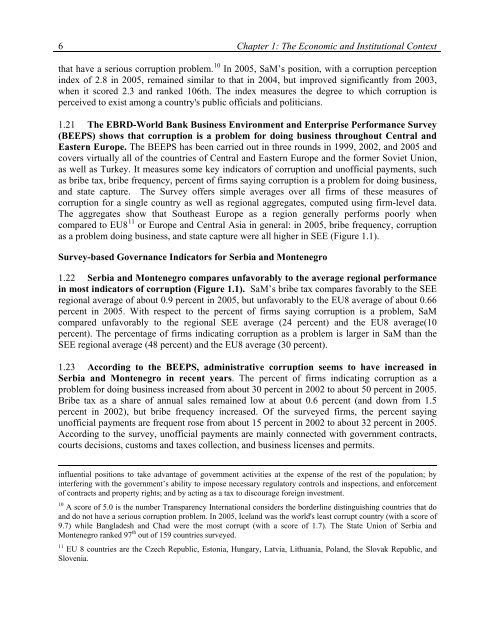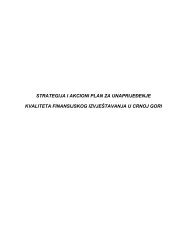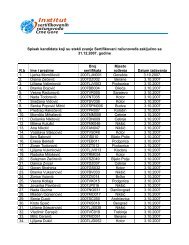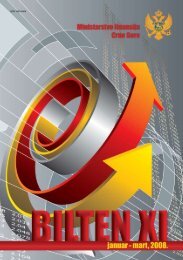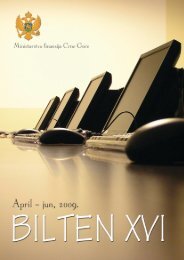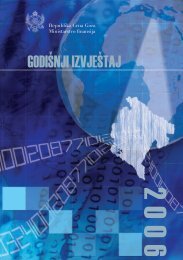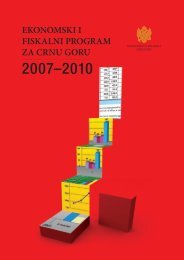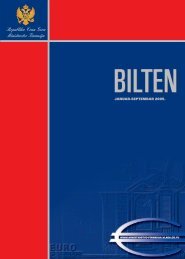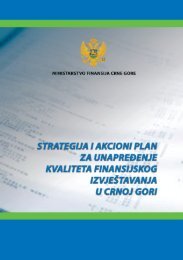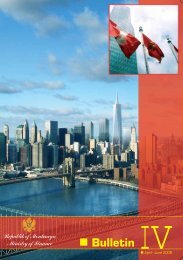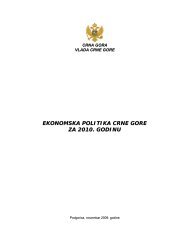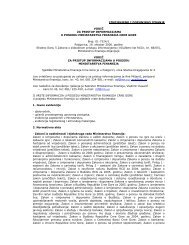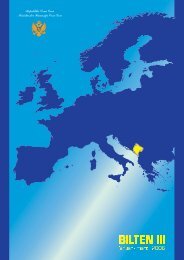Republic of Montenegro: Public Expenditure and ... - Vlada Crne Gore
Republic of Montenegro: Public Expenditure and ... - Vlada Crne Gore
Republic of Montenegro: Public Expenditure and ... - Vlada Crne Gore
Create successful ePaper yourself
Turn your PDF publications into a flip-book with our unique Google optimized e-Paper software.
6 Chapter 1: The Economic <strong>and</strong> Institutional Context<br />
that have a serious corruption problem. 10 In 2005, SaM’s position, with a corruption perception<br />
index <strong>of</strong> 2.8 in 2005, remained similar to that in 2004, but improved significantly from 2003,<br />
when it scored 2.3 <strong>and</strong> ranked 106th. The index measures the degree to which corruption is<br />
perceived to exist among a country's public <strong>of</strong>ficials <strong>and</strong> politicians.<br />
1.21 The EBRD-World Bank Business Environment <strong>and</strong> Enterprise Performance Survey<br />
(BEEPS) shows that corruption is a problem for doing business throughout Central <strong>and</strong><br />
Eastern Europe. The BEEPS has been carried out in three rounds in 1999, 2002, <strong>and</strong> 2005 <strong>and</strong><br />
covers virtually all <strong>of</strong> the countries <strong>of</strong> Central <strong>and</strong> Eastern Europe <strong>and</strong> the former Soviet Union,<br />
as well as Turkey. It measures some key indicators <strong>of</strong> corruption <strong>and</strong> un<strong>of</strong>ficial payments, such<br />
as bribe tax, bribe frequency, percent <strong>of</strong> firms saying corruption is a problem for doing business,<br />
<strong>and</strong> state capture. The Survey <strong>of</strong>fers simple averages over all firms <strong>of</strong> these measures <strong>of</strong><br />
corruption for a single country as well as regional aggregates, computed using firm-level data.<br />
The aggregates show that Southeast Europe as a region generally performs poorly when<br />
compared to EU8 11 or Europe <strong>and</strong> Central Asia in general: in 2005, bribe frequency, corruption<br />
as a problem doing business, <strong>and</strong> state capture were all higher in SEE (Figure 1.1).<br />
Survey-based Governance Indicators for Serbia <strong>and</strong> <strong>Montenegro</strong><br />
1.22 Serbia <strong>and</strong> <strong>Montenegro</strong> compares unfavorably to the average regional performance<br />
in most indicators <strong>of</strong> corruption (Figure 1.1). SaM’s bribe tax compares favorably to the SEE<br />
regional average <strong>of</strong> about 0.9 percent in 2005, but unfavorably to the EU8 average <strong>of</strong> about 0.66<br />
percent in 2005. With respect to the percent <strong>of</strong> firms saying corruption is a problem, SaM<br />
compared unfavorably to the regional SEE average (24 percent) <strong>and</strong> the EU8 average(10<br />
percent). The percentage <strong>of</strong> firms indicating corruption as a problem is larger in SaM than the<br />
SEE regional average (48 percent) <strong>and</strong> the EU8 average (30 percent).<br />
1.23 According to the BEEPS, administrative corruption seems to have increased in<br />
Serbia <strong>and</strong> <strong>Montenegro</strong> in recent years. The percent <strong>of</strong> firms indicating corruption as a<br />
problem for doing business increased from about 30 percent in 2002 to about 50 percent in 2005.<br />
Bribe tax as a share <strong>of</strong> annual sales remained low at about 0.6 percent (<strong>and</strong> down from 1.5<br />
percent in 2002), but bribe frequency increased. Of the surveyed firms, the percent saying<br />
un<strong>of</strong>ficial payments are frequent rose from about 15 percent in 2002 to about 32 percent in 2005.<br />
According to the survey, un<strong>of</strong>ficial payments are mainly connected with government contracts,<br />
courts decisions, customs <strong>and</strong> taxes collection, <strong>and</strong> business licenses <strong>and</strong> permits.<br />
influential positions to take advantage <strong>of</strong> government activities at the expense <strong>of</strong> the rest <strong>of</strong> the population; by<br />
interfering with the government’s ability to impose necessary regulatory controls <strong>and</strong> inspections, <strong>and</strong> enforcement<br />
<strong>of</strong> contracts <strong>and</strong> property rights; <strong>and</strong> by acting as a tax to discourage foreign investment.<br />
10 A score <strong>of</strong> 5.0 is the number Transparency International considers the borderline distinguishing countries that do<br />
<strong>and</strong> do not have a serious corruption problem. In 2005, Icel<strong>and</strong> was the world's least corrupt country (with a score <strong>of</strong><br />
9.7) while Bangladesh <strong>and</strong> Chad were the most corrupt (with a score <strong>of</strong> 1.7). The State Union <strong>of</strong> Serbia <strong>and</strong><br />
<strong>Montenegro</strong> ranked 97 th out <strong>of</strong> 159 countries surveyed.<br />
11 EU 8 countries are the Czech <strong>Republic</strong>, Estonia, Hungary, Latvia, Lithuania, Pol<strong>and</strong>, the Slovak <strong>Republic</strong>, <strong>and</strong><br />
Slovenia.


